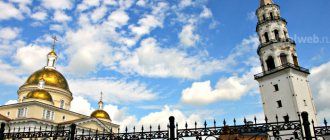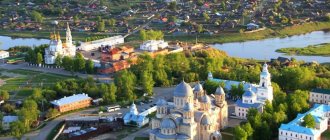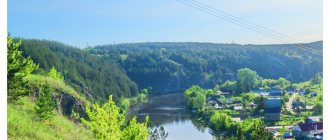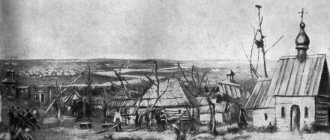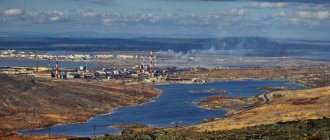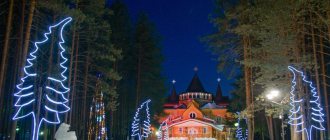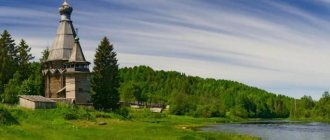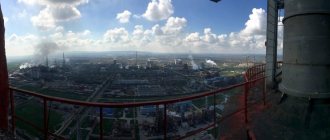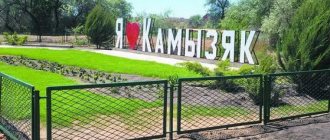Nevyansk is a city with a rich and interesting history. In the past, this is where the mining empire of the Demidovs began (essentially a state within a state).
The plant on the Neiva River (at that time it was called Nevya, hence the name of the city) was founded at the beginning of the 18th century by decree of Peter I. The date of birth of Nevyansk is considered to be December 15, 1701, when the first cast iron was smelted here. But already in March 1702, the Nevyansk plant was transferred from the treasury to the possession of the blacksmith Nikita Antufiev, the founder of the Demidov dynasty.
In the past, Nevyansk was often called the “Old Plant”, and the poet V.A. Zhukovsky called him “the grandfather of the Ural factories.” Indeed, among the cities of the Sverdlovsk region, Nevyansk is second only to Verkhoturye and Turinsk in age, and Kamensk-Uralsky is its same age.
In those days, the best iron in the world was produced in Nevyansk, the largest tsar blast furnace in the world at that time (!) worked here, a lightning rod was used for the first time, long before its official opening, reinforced concrete technology was used, and, it is believed, the first Siberian silver was secretly smelted ...
In the early 1720s, the Nevyansk plant alone produced two, and in other years, 3 times more metal than all three state-owned Ural plants (Kamensky, Alapaevsky, Uktussky). It was Nevyansk iron, as the best in the country, that for the first time in the history of Russia began to be exported to foreign countries. Until this moment, on the contrary, metal was brought to our country from abroad. For a long time, Nevyansk was the largest factory village in the Urals.
After the death of Akinfiy Nikitich Demidov in 1745, the Nevyansk plant went to his son Procopius. In 1769, the Nevyansk plant was bought from the Demidovs by Savva Yakovlev (Sobakin).
However, gradually all the forests, so necessary at that time for the operation of the plant, were cut down throughout the entire area. Because of this, the existence of the Nevyansk plant was in question. D.N. Mamin-Sibiryak wrote in the 1880s:
“Currently, the Nevyansky plant enjoys a very bad reputation in the Urals and is better known for the fact that its very existence hangs by a thread... If Akinfiy Demidov himself, the main tycoon and founder of the Ural factories, rose from the ground, and looked from the tower at the works of his hands, His iron heart would probably have shrunk with grief. The ancient factory nest is barely breathing, and the ancient iron, which made the glory of the Urals and bore its trademark “Old Sable,” seems to have been preserved only on the roofs of the ancient factory buildings...”
Even now there are vast treeless spaces at the approaches to Nevyansk.
One of the worst tragedies in the history of Nevyansk was the fire of 1890. On that ill-fated day, two thirds of the huge factory village at that time were destroyed by fire. Dozens of people died and thousands were left homeless. It was because of the fires that happened here that the documentation related to the Nevyansk Tower was not preserved, which is why many of its secrets will probably never be revealed.
There have been repeated strikes by workers at the Nevyansk plant. One of them is reminiscent of an exhibit in the park on Revolution Square - the so-called “goat”. This is metal frozen in an extinguished blast furnace.
Nevyansk is also famous for its gold. In the 19th century, Nevyansk was rightly called a “gold mine”. The yellow metal is still mined in the vicinity of Nevyansk. Gold panning machines are clearly visible near the highway.
Nevyansk Leaning Tower
The main attraction of the city is the Nevyansk Leaning Tower. Every year more than 100 thousand people from all over the Urals, from Russia and abroad come to see this architectural structure, shrouded in secrets and legends. Thanks to the tower, Nevyansk has become one of the largest tourist centers in the Sverdlovsk region.
There are many mysteries at the tower. Starting from the fact that it is not even known who built it and when (it is only generally accepted that it was most likely in 1725), ending with the auditory room and legends about the dungeons in which silver and gold were allegedly secretly smelted.
The tower is inclined (but not falling). According to legend, she looked askance because of Demidov’s sins. However, everything is much more prosaic. The slope appeared during the first stage of construction due to ground movement. This follows from the fact that the lower part is inclined more, and the higher it is, the smaller the angle of inclination, since they tried to level it.
For the first time in the world, a lightning rod was used on the tower spire, several years before its official opening.
English-made chimes work regularly on the Nevyansk Tower. The inscription on the chime bells remains: Richard Phelpsi Loncini Fecit 1730,” which translated from Latin means: “Richard Phelpsi, made in London, 1730.” Richard Phelps was a foundry master in London, and the bells of his work are installed on the chimes of St. Paul's Cathedral. The circumstances surrounding the acquisition of chimes by the Demidovs are unknown.
During Soviet times, the chimes did not work until they were restored in the 1970s by local craftsman Alexander Sakantsev.
During a tour of the tower, tourists see a theatrical performance. Akinfiy Demidov invites guests to make a commemorative coin themselves.
In addition, in one of the rooms of the tower, a scene of Demidov checking workers working in the basement was reproduced.
Tourists are also shown a secret staircase inside the walls that leads to the assay room - the “laboratory”.
The so-called auditory room is of greatest interest among tourists. In appearance, this is an ordinary room, but if two people stand in opposite corners of the room facing the wall and one of them pronounces words in a barely audible whisper, the other will not only hear them, but will feel that the sound is literally falling on him. This effect is explained by the vaulted ceiling. The sound seems to spread, glides along the arch in a narrow strip, practically without being reflected or absorbed along the way.
You can only get into the tower with a guided tour or a group. It's worth making an appointment in advance, especially if you're traveling on weekends.
The Nevyansk Tower is the most famous architectural landmark of the Sverdlovsk region. It is a historical and cultural monument of federal significance.
Next to the tower, in a red-brick restored power plant building from the 19th century, the Nevyansk Historical and Architectural Museum is located. The modernly designed museum presents exhibits from the history of the Nevyansk plant.
Coordinates of the Nevyansk Historical and Architectural Museum:
Nevyansk, Revolution Square, 2. Telephone: (34356) 2-25-01, 2-27-13, 2-20-56. Website: museum-nev.ru.
A single architectural ensemble with a tower and a power plant museum is formed by the Transfiguration Cathedral located here.
The temple was founded in 1824 and consecrated in 1830. Built at the expense of the Yakovlev breeders. In Soviet times, it shared the fate of most churches and was closed, going to the Nevyansk Mechanical Plant. After the Soviet pogrom it was restored in 2003.
The Transfiguration Cathedral is rightfully considered one of the most beautiful and majestic churches in the Urals. The bell tower of the temple reaches a height of 64 meters and is one of the highest in the Middle Urals.
A hundred meters from this architectural ensemble is Nevyansky Pond. This is the first factory pond in the Middle Urals. In the past, the gold-bearing bottom of the pond was shoveled by a dredge. Now the pond has the status of a hydrological natural monument.
Many ancient merchant houses have been preserved in Nevyansk. There are about 60 historical and architectural monuments here, although the condition of most of them is not good.
Transfiguration Cathedral
The majestic temple appeared in Nevyansk in 1824. After the revolution, there were industrial premises within the walls of the temple. During the war, aerial bombs were produced here.
In the early 2000s, restoration and restoration work began. In 2003, services were resumed in the temple, which became even more beautiful and majestic.
From the old one
“In the distance is a patch of lake and the tops of the towers. Lots of houses on the sides. The lake is moving apart, the towers are growing and growing. One turned out to be a cathedral bell tower, and the other was built in 1725, in the image of the Moscow Kremlin ones, only much higher than them. She glanced sideways, like the famous campanellas of Pisa and Bologna...
It was already dark when we drove through the wide streets of this plant, which is larger in size than any other city. There a bright flame flashed towards us. It turned out that the blast furnace was throwing it out, throwing it up, throwing it out of the round windows, throwing it up, throwing it out of the round windows, throwing it out into the open mouth of the stove, from where the ripened cast-iron milk was pouring out at that time...
There are many legends associated with the Nevyansk leaning tower. In its dungeons people were drowned, in its nooks and crannies people were buried, in its black dungeons and dungeons they kept harmful and dangerous opponents. Whether this is true or not, the walls will not tell anyone; The blood that was once shed does not show on the stone floors. The realm of ghosts has become the stuff of fairy tales; visions no longer appear to the curious tourist with tales of secrets and horrors that were once committed under these dark, heavy vaults. Legends remain in people's memory, and people stubbornly associate them with this old tower; the people say about it what people from the other world will not say, to the people every stain on these numb walls seems to be traces of murder, every mysterious noise in the wall - the groans of victims once tortured in stone bags; howling in the upper galleries - their cries: “You’d better not go into the basements!” There are fears there." Ask about what fears - it turns out that white flashes in the air, you can imagine skeletons clinging to the walls, as they clung to when the water flooded these dungeons; you can hear the clatter of bones in the corners and the traditional rattle of chains..."
IN AND. Nemirovich-Danchenko, fragment from the book “Kama and the Urals” (1890)
Museum "House of Nevyansk Icon"
In the 18th-19th centuries, the Nevyansk plant was a stronghold of the Old Believers. The Old Believers, persecuted by the authorities and the church, were willingly accepted in Nevyansk. Nevyansk owes a lot to them. In the same centuries, Nevyansk became famous for its magnificent Nevyansk Old Believer icon. It differs from the traditional icon in its brightness, grace and beauty. Nevyansk icon painting is a unique phenomenon of Russian artistic culture, which has become widespread outside the Urals. The Nevyansk icons were owned by the breeders Demidovs, Yakovlevs, the merchant Kharitonov and others.
Currently, a secular icon-painting workshop has been created in the city, with a private museum “House of the Nevyansk Icon” operating under it.
Icons from the workshop can be seen in the Church on the Blood in Yekaterinburg and in other cities of Russia. There are icons from the Nevyansk workshop outside our country. For example, Queen Catherine II of Great Britain in Buckingham Palace.
A collection of more than 300 examples of Nevyansk icon painting is presented here. In the museum you can see both exhibits that are several centuries old and colorful modern icons. The museum is located just a few minutes walk from the Nevyansk Tower.
Museum address: Nevyansk, st. Krasnoarmeyskaya, 2. Tel.: +7 (34356) 2-40-05. Website: www.new-ikona.ru.
Nevyansk Sverdlovsk region. Description of Nevyansk.
Nevyansk city is located in the Sverdlovsk region, is the center of the municipal formation Nevyansky district, located on the Neiva River (previously the river was called Nevya).On the territory of the Nevyansky district there are 36 towns, villages and villages.
Nevyansk covers an area of 3,913 hectares. Nevyansky district covers an area of 196,748 hectares.
Nevyanskaya Sloboda was founded in 1621.
December 15, 1701 is considered the founding of the village of Nevyansky Zavod (considered the date of birth of the city of Nevyansk).
In August 1919, Nevyansk received city status.
In 1924, the Nevyansky district was formed.
On April 23, 1996, the municipality of Nevyansky District was formed.
Nevyansk city code: +7 (34356)
Coat of arms of Nevyansk: the symbol of Nevyansk is the inclined tower of the Demidovs, three ore vines (switched to the modern coat of arms from the coat of arms of the Demidov family), a pyramid of cannonballs engulfed in flames (a symbol of the fact that weapons production was carried out at the Nevyansk plant). The silver background of the coat of arms and flag denotes the metal that the Ural subsoil is rich in. The green stripe at the bottom indicates natural resources.
The population of the Nevyansk region is 47,000 people (2002), more than 25,000 in Nevyansk.
History of Nevyansk
In the first millennium BC, one of the oldest centers of metallurgy was formed in the Ural Mountains (Riphean Mountains). The territory adjacent to the Neva River and its tributaries formed the core of the Ural mining and metallurgical province. Here, copper ore bodies with easily processed native or oxidized metal came out close to the surface. Archival materials speak of ancient mines in this territory. Mining and processing of minerals here was carried out by the ancient people of miners and metallurgists - the “white-eyed Chud” (representatives of the Finno-Ugric tribes). Later, based on the characteristics of the “Chud mines,” ore explorers found the now known deposits. Russians came to the Urals in the mid-14th century. These were Novgorodians, pressed by the Moscow principality. In 1364 they crossed the Ural ridge and reached the lower reaches of the Ob. And the first settlements were established in the Trans-Urals. After the fall of the Kazan, Astrakhan and Siberian khanates, colonists flocked to the Urals in droves. This was a spontaneous process; it affected mainly the peasant class. They were attracted by the fertile lands of the eastern slope of the Urals and Trans-Urals. Here, settlers from Pomerania, regions of the Russian North, and the Northern Volga region settled in settlements, forts and graveyards. The settlement of the Urals was especially intensive in the 17th century. In the Nevyansk district there appeared: the Nevyanskaya settlement with a fort on the Neiva River (1626), the Aramashevskaya settlement on the Rezh River, a tributary of the Neiva (1631), the Murzinskaya settlement at the confluence of the Anbarki River with the Neiva (1640), the Krasnopolskaya settlement at the confluence of the Viluy River (1654), Ayatskaya on the Ayat River (1669). One of the first monasteries in the Urals, Nevyansky Epiphany, also appeared on Nevyansk land.
Crafts related mainly to primitive metallurgy developed in the settlements. From the swamp ore (a type of brown iron ore formed at the bottom of the swamps in the form of small grains) they obtained kritsa iron and metal processing - in forges from kritsa through long forging - a metal suitable for use. Iron was used for the manufacture of agricultural implements and household needs. The seventeenth century in the Middle Urals is associated not only with the processing of iron in suburban forges, but at this time the first objects of industrial metallurgy also appeared.
In the fall of 1628, the blacksmith of the Nevyansk fort Bogdan Kolmogor found swamp iron ore seven miles from his settlement. Samples of it were sent to Tobolsk, to the voivodeship residence. The Siberian authorities became interested and sent two specialists to study the iron deposit in detail. When examining the area, several more iron deposits were discovered along the Neva and Tagil rivers. One of the places gave rise to the Nitsin ironworks on the Nice River, a tributary of the Neiva. In 1630, the first furnace-furnace was built here, and a year later the first state-owned factory began operating, which already had four furnaces and several forges.
The main “initiators” of the iron industry in the Nevyansk region are considered to be people from the family of professional ore miners and metal smelters, the Tumashevs.
In 1696, the head of the Siberian order, Andrei Andreevich Vinius, sent an order to the Verkhoturye governor Dmitry Protasyev, which required the governor to report: “in which places there is a magnet stone and good iron ore...”. In January 1697, the voivode informed that a magnet stone was found on the banks of the Tagil River, and iron ore was found in four places along the banks of the Neiva River and sent samples of ore. Samples of ore were sent to Moscow, they were checked for quality by specialists from the Cannon Yard in Moscow, in Holland, and they also sent samples to the Tula ironworks master Nikita Antufiev (later Demidov). Nikita Antufiev gave his conclusion that the iron is good, no worse than Swedish, and even better in the arms industry.
In March 1700, the first batch of artisans arrived for the construction of a state-owned ironworks on the Neiva River (previously the river was called Nevya). And on December 15, 1701, the Nevyansk blast furnace produced the first cast iron.
In May 1697 A.A. Vinius writes a letter to Peter the Great that good quality iron ore has been found and asks for his permission to search for convenient places to build factories. A convenient place for building a plant is the presence of a “small” river, not stormy or capricious for the construction of a dam, the proximity of good ore and forests as fuel for future domains, as well as the nearby presence of navigable rivers so that the finished iron can be transported by water. They didn’t worry about workers - there were a lot of settlements around, and the Ural ore miners, smelters, and blacksmiths had already proven themselves to be the best. We identified several convenient places for the construction of factories, and found convenient places where the Nevyansk plant would later be built, and then the city of Nevyansk would develop.
In March 1700, to the future Nevyansky, as well as hammer workers, coal masters and apprentices, ore specialists and blacksmiths. The Verkhoturye voivode appointed Mikhail Bibikov, who was far from the factory business and an inept organizer, to supervise the construction of the Nevyansk plant. Construction of the plant proceeded slowly, the Tobolsk governor reacted in his own way - he recalled the dam master Ermila Yakovlev and sent him to the Kamenka River, where another state-owned plant was being built - Kamensky. After this, the construction of the dam on the Neiva froze, because... The apprentices, left without a master, practically stopped working. In the spring of 1701, the inept Bibikov was removed from leadership and a man from Moscow, Semyon Vikulin, was appointed. After this, construction revived in May 1701, they began to build a dam, a blast furnace, barns for hammers, coal sheds and residential huts with baths. But the construction site was unlucky; the new dam master suddenly left, and the other one who remained could not cope with the work; then in October 1701, a fire broke out and destroyed much of what had been built; the workers fled, leaving the plant empty. The plant was restored and on December 15, 1701, cast iron came out of the blast furnace, and at the beginning of 1702 the first iron was smelted, which was sent to the Tsar for testing, then it turned out to specialists for testing that Nevyansk iron was better than Swedish in its softness. Despite the good quality of the iron, the Nevyansk plant, and all the state-owned Verkhoturye plants, did not reach the required productivity. Due to unnecessary quarrels and the lack of diligence of plant managers, the treasury suffered losses and a lot of time was wasted in vain. The Northern War was going on, weapons and iron were needed. At the beginning of February 1702, Nikita Antufiev (Demidov) asked the Siberian order to grant him the Nevyansk factories. At the beginning of March, a decree was issued on the transfer of the Nevyansk plant to Nikita Demidov. By decree, other factories on the Neiva River and the Tagil River near magnetic ore also went to Nikita Demidov. In September 1702, a new decree appeared, which prescribed the construction of new factories, gave new privileges, lands, Ayatskaya, Krasnopolskaya settlement with villages with all the peasants. In the spring of 1703 the dam broke, it was repaired, and in the fall it broke again. By decree of April 4, 1704, Demidov was granted additional privileges. In the summer of 1704, the dam was restored and expanded. From this year on, the fame of the Nevyansk plant grew. Soon the Nevyansk plant became the largest metallurgical enterprise in Russia, producing cast iron and iron tens of times more than all the state-owned factories of the Stone Belt. Nevyansk metal was also distinguished by its high quality, Nevyansk metal had its own brand, the mark “Old Sable”, the metal was willingly taken not only in Russia, but also abroad, the main consumer of Nevyansk metal was England. On Nevyansk (built in 1740), the Nevyansk “Tsar Blast Furnace” produced tens of times more cast iron per day than any of its English counterparts, which were then considered the largest in the world. And when Grigory Makhotin, a Demidov master, came up with two-tuyere blasting (supplying air into a blast furnace through a special channel - a tuyere), supplying air into the furnace through two nozzles, the productivity of the blast furnace became fantastic for those times. The height of the “tsar blast furnace” was more than 9 meters.
After the death of Nikita Demidov in 1725, the entire mining industry in the Urals passed to his son Akinfiy Demidov. He multiplied it and by 1736 the “Demidov kingdom” with its capital in Nevyansk consisted of 22 iron and copper factories, 96 mines, 36 villages with numerous villages, and three marinas. About 36 thousand workers and employees worked in this kingdom. In 1735, the first factory in Russia for the production of braids was built in Nevyansk. On the map of the Urals there is an inscription: “Department of Akinfiy Demidov”, a territory similar to some European states. It was a real state within a state: it had its own court, its own laws, its own army, its own fortresses, its own guns.
The first shock in the Demidov kingdom occurred after the unexpected death of Akinfiy Demidov in 1745. He bequeathed his entire Ural farm to his son Nikita, which the other sons did not agree with. The litigation continued until May 1, 1758. The Nevyansk group of factories (Nevyansky, Shuralinsky, Verkhnetagilsky, Byngovsky, Shaitansky, etc.) went to the eldest son Prokofy Demidov. He lived in the capital and was not interested in the mining business, and in 1769 he sold the Nevyansk group of factories. The buyer was Savva Yakovlevich Yakovlev (formerly Sobakin). Having replaced the owner, the Nevyansk plant developed and until the end of the 18th century remained the best iron and ironworks in the Urals. The peak of the plant's productivity came in 1812, when the Yakovlevs received large orders for military supplies of shells, cannonballs, and buckshot.
In the 18th century, the settlement of Nevyansky Plant ranked third in terms of population in the Urals after Orenburg and Yekaterinburg. According to Academician P.S. Pallas, who visited Nevyansk in 1770, it had 1,200 houses and 4,000 male people. Crafts and trade developed in Nevyansk. Famous merchants of the first guild lived and had trading shops, who traded in Yekaterinburg and Nevyansk. Nevyansk had an advantage over Yekaterinburg; it was a village, so the duties here were lower.
However, at the beginning of the 19th century, a crisis at the plant was revealed. It manifested itself in the shortage of nearby ore and nearby coal for furnaces. Nearby ore deposits and forest lands have been depleted. Decline became inevitable, as did the decline of the entire Ural metallurgy. By the end of the 19th century, production volumes were miniscule and the Nevyansk plant began to be forgotten.
On August 19, 1878, the first train on the Yekaterinburg-Kushva section passed through Nevyansk along the mining road. The railway did not help the plant, but it gave the city a new impetus.
In 1890, a huge fire destroyed 2/3 of the factory. In the first decade of the 20th century, the Nevyansk plant turned into a mechanical enterprise. The Nevyansk plant began to produce: steam boilers, cast iron water pipes, pumps, locomotives, dredges for the extraction of placer gold and platinum. In total, the plant built about 30 dredges at different times, mainly for Siberian mines.
On April 25 (May 8), 1914, a cement plant with a capacity of 360 thousand barrels was launched near Nevyansk. The cement plant in Nevyansk is still operating.
In 1915, the Nevyansk Artillery Plant began operating.
Handicrafts were further developed in Nevyansk: shoe making, chest making, ironware, carriage making, etc. Nevyansk chests with beautiful iron frames (the so-called “frozen” iron) were especially famous, which went to Central Asia, to the Nizhny Novgorod and Irbit fairs, to Persia .
In terms of population, Nevyansk continued to be among the largest factory settlements in the Middle Urals. In 1910, Nevyansk had a population of 17,300. Of the 3051 residential buildings, there were 64 stone houses. The market square was dotted with numerous wooden shops and stalls. There was a stone courtyard on it, divided into 48 separate shops. On the right bank of the Neiva there were flour and butcher shops, a “glutton row”. In Nevyansk there were 6 schools (including a women's gymnasium and a higher primary school), a hospital with 40 beds, a club, a post and telegraph office, 5 churches, etc.
In August 1919, Nevyansk received city status.
In the 20s of the 20th century, the plant began to repair railway cars and mining equipment that worked in the mines of the city of Kirovgrad (the old name of Kalata). Later, the Nevyansk plant became one of the enterprises of the military-industrial complex and became a sensitive closed enterprise.
In the 30s of the 20th century, the rapid development of Nevyansk began. The metallurgical plant has turned into a large enterprise equipped with modern equipment. An industrial plant, a meat processing plant, and artisanal artels arose in the city. Institutions for cultural and everyday purposes appeared (House of Culture, club, cinema, water station, etc.), and multi-storey buildings began to be built.
In 1939, 28.2 thousand people lived in Nevyansk. In the war and post-war years, the growth of the city and its population was associated with the reconstruction and expansion of existing industries, the construction of a number of local industrial enterprises, the development of service functions, and the improvement of municipal services. In 1959, Nevyansk had 30.9 thousand inhabitants.
As of 2010, the population of Nevyansk is about 25 thousand people
Nevyansk Leaning Tower
In Nevyansk, below the dam of the factory pond, there is the famous “falling” Nevyansk Tower, which still holds many unsolved secrets. Nevyansk is the first “capital” of the Demidovs. The Nevyansk leaning tower was built in 1722-1732 according to the type of Russian hipped bell towers. The base of the tower is a square with a side of 9.5 meters. Its height is 57.5 meters. The tower consists of a quadrangle (quadrangular base), on which are placed three tiers of decreasing octagons, decorated with patterned ornaments and zirconia gratings. The tower is crowned with a metal cone-shaped tent with a flag and a lightning rod. The weathervane depicts the noble coat of arms of the Demidovs: a knight's helmet with a visor and feathers and a shield with an image of a hammer. The thickness of the walls at the bottom of the tower reaches 178 centimeters, and at the top 32 centimeters. The author of the Nevyansk leaning tower project is unknown. The builders of the tower proved themselves to be innovators and inventors. Nevyansk residents were one of the first in Russia to use metal structures in the construction of the tower. A major invention was the use of iron beams, which combined two dissimilar metals—a cast iron beam and an iron rod—to increase strength. A similar technique was used only centuries later with a similar combination of iron and concrete. It is believed that the inventor of the lightning rod is B. Franklin (1752), but two decades before this event the lightning rod was already in the Nevyansk Tower. The Nevyansk leaning tower was part of a large industrial complex, performing a number of important functions. From the Nevyansk inclined tower, the surrounding roads and fire safety in Nevyansk were monitored; the clock indicated the exact time; on the lower floors of the tower there was a factory archive, a treasury office, a prison, and a factory laboratory. But it is believed that the main role of the tower is symbolic. The building was a sign of the power of the Demidov dynasty. The Nevyansk Tower is often compared to the Leaning Tower of Pisa, but unlike it, the Nevyansk Tower is not leaning, but inclined. There are two versions of the tilt of the tower: it was specially built this way (the Demidovs wanted to be original) or the tower tilted during construction due to ground subsidence (the tower is located on the shore of a pond). According to the second version, during the construction of the quadrangle, the ground subsided on the southwestern side and the building tilted. A few years later, construction continued, trying to straighten the tilt of the tower. The structure acquired a saber-shaped bend: if the quadrangle is deviated from the vertical axis by three degrees, then the upper octagon with the tent absolutely corresponds to this axis. This is why the large metal weather vane quietly rotates in the wind. If there had been even a slight tilt, the heavy blade of the weather vane would always remain motionless.
In terms of the number of legends and traditions, the Nevyansk Leaning Tower has no equal. According to legend, silver was secretly smelted and coins were minted in the basements of the Nevyansk leaning tower. On the third floor there is a factory laboratory; a staircase leads to this laboratory, which is located inside the wall, in which the quality of the ore and the content of various components in it were determined. According to legend, this laboratory was created primarily to determine the silver content in ore. If the analysis was positive, this ore was allegedly smelted in deep secrecy to obtain the precious metal. In our time, as a result of chemical examination of soot from the chimney of the Assay Forge, a high content of silver was discovered. It is assumed that there is not only one staircase inside the walls, that there were other similar staircases for secret descent into the dungeons or ascent to other tiers.
There are legends that the Nevyansk plant had underground passages through which it was possible to move unnoticed from one building to another, but no one was engaged in excavations properly, with the exception of enthusiasts, but for one reason or another it was never possible to complete the excavations, even if If any underground premises are discovered, then completely unexpectedly and accidentally, as happened in 1890 after a giant fire, sinkholes appeared on the territory of the old plant. One of them discovered an underground room in which smelting forges were found. From the underground smelter the entrance led to the tower.
On the sixth floor of the tower there is a “hearing room”. If two people stand in opposite corners of the room, facing the wall, the quiet whisper of one will be heard by the other. According to legend, Akinfiy Demidov created similar rooms for receiving important guests in order to find out all the secrets of their secret conversations. On the first octagonal tier of the Nevyansk Tower there is a clock mechanism of the famous English chimes. In 1767 they were valued at 5,000 rubles, while the construction of the entire tower cost 4,207 rubles 60 kopecks. Here you can see how the ancient clock on the Nevyansk Tower works. Above there are 10 bells that chime every 15 minutes, and a melody sounds eight times a day. In the center is a bronze alarm bell with the inscription: “SIBIR. On the 1st day of June 1732, this bell was cast in the Nevyansk nobleman Akinfiy Demidov factories, weighing 65 poods 27 feet.” The musical drum of the clock mechanism is programmed with 18 English melodies: folk songs, minuets, marches of the late 17th and early 18th centuries. In the 20th century after 1917, the clock remained silent for many decades. Some of the parts from the watch were lost, some were lying or rather lying around in a disassembled state (3109 parts), but thanks to the talent, diligence and patience of A.I. Sakantsev, not only the movement of the clock was started (1975), but also solved on the punch card of a musical drum. As a result, all the old melodies were restored. In 1985, the Nevyansk supplemented them with “Mendelssohn’s March”, “Glory” and a fragment from the opera by M.I. Glinka “Life for the Tsar” (“Ivan Susanin”).
Transfiguration Cathedral
The Nevyansk leaning tower is considered the main symbol of the Demidov dynasty, then the Nevyansk Transfiguration Church is the most majestic structure built by the new owners of the Nevyansk plant, the Yakovlevs. The temple was erected in 1824-1830, 13 fathoms from the inclined Nevyansk tower. In the mid-19th century, the temple was expanded and a bell tower was built. According to legend, either the new owners of the plant, or the local priest who was involved in the construction, set the condition that the bell tower of the church be higher than the Demidov tower. It was with this in mind that the bell tower was erected. However, upon completion of construction, it still turned out to be lower. Then it was decided to erect a spire with a cross on top of the bell tower. This is the only way she became taller than the leaning tower. Today, the restored bell tower is the tallest of the bell towers in the Middle Urals, its height is 64 meters. By the beginning of the 60s of the 19th century, the Transfiguration Church acquired the appearance that allowed contemporaries to consider it one of the best in Russia, and unparalleled in the Urals. In May 1912, by decree of the Synod, the Transfiguration Cathedral was given the status of a temple. In 1932 the temple was closed. The cathedral building was transferred to the Nevyansk Mechanical Plant. The new owners demolished the bell tower, dismantled the dome and vaulted ceiling. By decree of the governor of the Sverdlovsk region E.E. Rossel begins the revival of the Nevyansk shrine. On August 16, 2003, the consecration of the restored Transfiguration Cathedral took place. As in the old days, the temple amazes with its beauty and size. Its interiors are decorated with five faience iconostases made at the Sysert porcelain factory. The cathedral became the third temple in the Urals for which Sysert craftsmen produced their products. In recent years, the temple has acquired two ancient shrines: the icon of St. Nicholas and the icon of St. Evangelist John the Theologian.
Nevyansk Tower excursion:
Information on the city of Nevyansk was provided by the head of the department for work with visitors of the Nevyansk State Historical and Architectural Museum Yulia Yakovlevna Privalova. Museum phone number: +7 (34356) 2-20-56 Address of the Nevyansk Museum: Nevyansk, st. Revolutions, 2 Telephone numbers of the Nevyansk Museum for excursion registration: +7(34356) 2-25-01, tel/fax: +7(34356)2-27-13
Economy of Nevyansk
Nevyansk has developed metalworking and mechanical engineering, cement and building materials production, knitwear, printing, forestry, food industries, and gold mining. 60% of all gold mining in the Sverdlovsk region is carried out in the Nevyansky district. There are enterprises of the agro-industrial complex: a meat processing plant, a dairy plant, and a bakery.
There is a cement plant in Nevyansk, located at Nevyansk, Tsementny village, st. Lenina, 1.
In the city and region there are 20 general education institutions, 4 additional education institutions, 23 kindergartens, two vocational lyceums, a mechanical college, a branch of the Ural State Technical University, 46 cultural institutions, 50 sports facilities, and a developed healthcare network.
There are 408 trade, catering and consumer services enterprises operating in the territory; 97% of their structure is small business and entrepreneurship.
Nevyansk is the center of a large industrial-agrarian region. To the south of Nevyansk there are significant urban-type settlements: Verkh-Neyvinsky (7.4 thousand inhabitants), Kalinovo (4 thousand inhabitants). Even further south is the village. Ayat (3.0 thousand inhabitants) (peat is being mined). To the north of Nevyansk there are a number of large rural settlements gravitating towards it, in which industrial production has developed significantly: the fairly large village of Byngi (2.7 thousand people), the village of Nizhnie Tavolgi, where artistic ceramics and pottery are produced.
Gold mining in Nevyansk
There was no gold in Nevyansk or in the outskirts of Nevyansk in the 18th century, and if it was found, it was carefully hidden by the Demidovs. It was hidden due to ineffective laws in force in the 18th century. And according to the law, any land where gold or silver was located immediately passed to the state, regardless of whether this land was empty or there were any buildings on this land. Only the state could mine gold. It turned out that if gold was discovered and the Demidovs’ ironworks that had been built could go to the state, it would be more profitable not to find gold, or at least not to advertise the find. Search teams equipped by the state did not find gold; the Demidovs, and then the Yakovlevs, did everything in their power to ensure that the gold was not discovered. There are many legends about the secret smelting of silver in the Nevyansk Tower, but whether silver was smelted there or not - there are no facts, only legends.
Gold began to be discovered in the Nevnsky region after 1812, when a decree was issued “On granting the right to all Russian subjects to find and develop gold and silver ores with payment of taxes to the treasury.” After this decree, it was possible to look for gold or silver without fear, and they were not afraid that the gold-bearing lands would be taken away by the state. Gold was found in the Verkh-Neyvinsk area, in the valley of the Neiva River above Nevyansk, along the banks of the Olkhovka, Fetkovka, Shaitanka rivers, and in the village of Shurala. Mines appeared: Shuralinsky, Kalatinsky, Khmelevsky. Gold mining greatly saved the Nevyansk people when the Nevyansk plant stopped working or when it hardly worked. Gold is still mined in the vicinity of Nevyansk.
Real Estate Agency Region-Market LLC - time-tested reliability Address: 620114 Ekaterinburg st. Khokhryakova, 98 Shopping center "Vesenny", 3rd floor, office 40
Phones, Phone/fax, +7-950-633-12-67
Byngi village
The Old Believer village of Byngi is located 7 kilometers from Nevyansk. In 1718, an ironworks was founded here - a satellite of Nevyansk. Now there is no trace of him left. In 1873, the plant was stopped, the pond was drained, and in its bed they began to wash gold, of which a lot was discovered here. By the way, an interesting fact is connected with the pond. In the early 1870s, “two bones, a tusk and a mammoth tooth and 10 bones” were discovered at its bottom, which were transferred to the museum of the Ural Society of Natural History Amateurs (UOLE), which was being created at that time in Yekaterinburg.
The name of the village comes from the Bynga river, the name of which comes from the Mansi Elbyng-ya - “Holy River”. This means that these places were revered among the Voguls. By the way, not far from here the oldest wooden sculpture on our planet was found - the Shigir idol.
The main attraction of the village that attracts tourists is the temple in the name of St. Nicholas the Wonderworker. The temple is one of the oldest in the Middle Urals. It was founded in 1789 and consecrated on September 30, 1796.
According to legend, after the death of the factory owner Savva Yakovlev, disputes began among his sons over the inheritance. One of the sons, Pyotr Savvich, swore that if the Nevyansk factories were transferred to him, he would build an unprecedented temple. When Peter Yakovlev’s wish came true, he kept his oath and gave the order to his manager: “If possible, cast a cast-iron church in Byngi in the name of St. Nicholas of Christ: if this cannot be done, then build a glorious temple there, do not spare anything, which will be marveled at.” and which would never exist..."
The temple is unusual due to the abundance of cast iron. The entire floor and steps are covered with patterned cast iron slabs, and the walls are reinforced with metal ties. The temple is also unusual due to the presence of ancient chimes on the bell tower. By the way, these are local chimes made in Nevyansk. Alas, the chimes are not working now.
In the temple itself there are ancient icons of the 18th-19th centuries, belonging to the famous Nevyansk school of icon painting. The frescoes painted on the walls are also very interesting.
The temple is quite well preserved, since it was not destroyed during Soviet times. It is currently being restored by the Drug Free City Foundation. St. Nicholas Church Byneg is a historical and cultural monument of federal significance.
Next stands another religious building in Byneg - the Edinoverie Church of the Kazan Mother of God.
Byngi is also interesting for its ancient houses with carvings - excellent examples of wooden architecture of the second half of the 19th - early 20th centuries. One of the most striking examples is located near St. Nicholas Church.
It, as well as the temple and other views of Byneg, can be seen in the first Soviet serial film “Gloomy River” (1968). By the way, for the filming of this film, they even dug up electric poles on the street and near the church so that they would not get into the frame.
Holy Trinity (Royal) Church
The four-pillar, five-domed temple was built according to the design of the architect K.A. Ton. The brick church in the Russian-Byzantine style received parishioners in 1853.
In 1937, the temple was closed; three years later, by order of the ideologists of Bolshevism, all the domes were destroyed. Only in 1995 the community was able to return the temple.
Funds for restoration have not yet been found. Now the architectural monument has the status of a bishop's courtyard.
Address: st. Krylova, 20.
Upper and Lower Tavolgi
Further along the route, tourists will meet Upper and Lower Tavolgi. Meadowsweet is a medicinal herb (also known as meadowsweet). It grows in abundance along the Tavolga River flowing here.
Both villages are famous for their pottery crafts. This fishery was developed thanks to local high-quality red clay. Before the revolution, dozens of workshops operated in these villages.
The Tavolzhskaya Ceramics enterprise (formerly the Nevyansk Art Ceramics Factory) operates in Nizhny Tavolgi. In 2013, a couple of guest houses were built on its territory where you can stay. There are plans to build an entire village street with access to nature for tourists.
At the Tavolzhskaya Ceramics enterprise
Director of the enterprise A.G. Nazarov
Here, in Nizhniye Tavolgi (at the entrance to the village on the left), stands the house of the hereditary potter Sergei Maslikov. The Maslikov family welcomes tourists on excursions and master classes.
Sergei talks captivatingly about his craft, interspersing it with funny jokes. Pottery making is not as simple as it might seem from the outside. In order to fashion a product, you need to do a lot of things. Sergey interestingly tells how clay was “cultivated” and pottery was made in the past and how it happens now. By the way, the Maslikov family alone uses 10-12 tons of clay per year for pottery.
Those who wish can practice making pots on a potter's wheel and making toys here. After this, the owner of the workshop will give you healing meadowsweet tea with pancakes.
Phone numbers of the Maslikov pottery workshop in Nizhny Tavolgi: 8-952-14-34-449, 8-912-61-48-837. Website: gonchar-iz-tavolog.ru
There is a similar workshop in Verkhniye Tavolgi. It belongs to the already mentioned above enterprise “Tavolzhskaya Ceramics”. After visiting the museum located here, you can try your hand at sculpting and painting clay products, and take the resulting masterpiece as a souvenir. You can also order lunch. An Old Believer chapel was built on the territory of Tavolzhskaya Ceramics.
Telephone numbers of Tavolzhskaya Ceramics: 8-982-658-17-30, 8-953-003-80-17. Website: tavolgatur.ru
You should sign up for excursions to pottery workshops in advance.
How to get to Nevyansk?
The city of Nevyansk is located in the Sverdlovsk region, 92 kilometers north of Yekaterinburg. You can get here along the Yekaterinburg - Nizhny Tagil highway, as well as by buses, trains or electric trains (Ekaterinburg - Nizhny Tagil). There are buses from the center of Nevyansk to Byneg, Verkhniye and Nizhnye Tavolog.
Pavel Raspopov
UraloVed.ru
PS “Uraloved” thanks the Tourism Development Center of the Sverdlovsk Region and “TurExpoService” for the information and advertising tour to Nevyansk and Tavolgi.
See also:
The terrible fire of 1890 at the Nevyansk plant
Trip to Nevyansk and Byngi (08.11.2014)
House of the blacksmith Kirillov in Kunar
Nevyansk State Historical and Architectural Museum
The museum is located in a former power station built in the 19th century. Here you can see the original portrait of Nikita Demidov, an almost meter-long nail taken from the base of the dam, models of smelting furnaces and other factory equipment. On the second floor there is an exhibition dedicated to the history of the Nevyansk region in the 19th and 20th centuries.
Additional services:
The Nevyansk Museum organized interactive classes for children “Mother's Saturdays”. Held every Saturday from 12.00-14.00 for children aged 4-10 years. During the classes, children get acquainted with ancient household items and learn about the nature of the region. Inquiries by phone: 8 (34356)44-509,4-99-63
General information:
Address: Sverdlovsk region, Nevyansk, pl. Revolutions. Museum opening hours for visitors: Tue - Sun: from 09.00 to 18.00, Wed: from 09.00 to 20.00 (by prior arrangement). Monday is a day off. Telephone/fax: to sign up for an excursion - tel. (34356) 4 45 09
Show on the map
Services and prices:
- Tour of the museum - duration of the tour is 1.5 hours. The minimum number of visitors is 5 people. The entrance ticket costs 180 rubles/adult, 120 rubles/student, 100 rubles/schoolchildren and pensioners. For groups of 1-4 people - 1000 rubles. from the group
- Tour of the tower - duration 1.5 hours, entrance ticket price - 350 rubles/adult, 280 rubles/students, 250 rubles/schoolchildren and pensioners.
- Theatrical performance - 2500 rubles. from a group (from 1 to 25 people), by prior agreement
- Excursion to the Transfiguration Cathedral; entrance tickets cost 100 rubles/adult, 70 rubles/students, 50 rubles/schoolchildren and pensioners. Entrance ticket price (for groups from 1-4 people per group) - 500 rubles.
- Quest excursion “Demidov’s secrets”. Group from 1 to 10 people - 10,000 rubles (over 10 people - additional payment of 1,000 rubles per person)
- Making a “coin” - 200 rubles.
Related articles
July 3, 2022
Byngi
June 26, 2022
House of the blacksmith Kirillov
June 15, 2022
